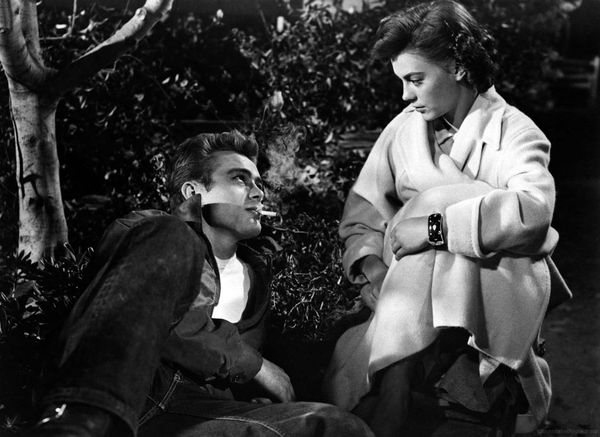Eye For Film >> Movies >> Rebel Without A Cause (1955) Film Review
Rebel Without A Cause
Reviewed by: Chris

Rebelliousness. Testosterone. Driving force.
In the cool light of day, knowing where the anger comes from and what it is directed at often saps the charisma around such things. It lets us explain it away. When there is no such reason, no cause, it acquires an almost godlike status, beyond logic and argument. This is the film that launched the icon that was James Dean. His name now litters countless songs as the immortal symbol of teenage angst, a figure of non-aggressive but charged masculinity almost without equal. The film title, taken from a psychologist's collection of juvenile case studies, captures the imagination even before we see the movie.

Jim Stark (James Dean) meets the sweet, unloved Judy (Natalie Wood) - the girl destined to be his sweetheart - when they are pulled into a police station at the start of the film. Through no fault of her own, she has been mistaken for a streetwalker. Jim is just 'plain drunk'. Also in the police station is an emotionally disturbed youngster called John, or 'Plato'. Plato's anger and aggression can take a more violent turn, but he also a victim of circumstances whose parents care nothing for him.
The teenage cry of "You don't understand me!!" could not be portrayed more meaningfully right from scene one.
Judy's boyfriend, Buzz, is the leader of the gang and taunts her new friend. Jim is torn between always trying to avoid trouble but never wanting to be seen as 'chicken'. Buzz manipulates him into a flick-knife fight, which acts as prelude for the even more dangerous 'chicken run' challenge - racing stolen cars towards a cliff edge and jumping out at the last minute.
Rebel Without A Cause continues the themes of teenage alienation with great dexterity and insight. Plato befriends Jim and Judy, eager for companionship. He guides them through a derelict gothic mansion. Here, and in the nearby planetarium, the stories of love, friendship and violence reach a dramatic and tragic climax.
The strengths of Rebel Without A Cause that set it apart from the multitude of inferior copies are numerous. (Teenage rebellion films multiplied exponentially in the years immediately following its release.) In terms of substance, it follows both expert psychological profiling and distinguished Method Acting. Stylistically, it is a showpiece of evocative cinematography.
Cinemascope was still quite new and is used here to remarkable effect. In the police station, Jim, Judy and Plato (who don't know each other at this stage) are sectioned across three discrete pockets of the set. We can see each third portraying the distinct individuals with their own storylines. Later, before the first real kiss, the wide screen is used effectively at closer quarters in a head-and-shoulders shot. Here, Jim lies on his back and we see him side-on, motionless but inviting, as Judy exchanges sweet nothings with him, gradually edging closer. The length of the screen continues in our imagination - we feel their bodies should be entwined. This build up to the first kiss is maybe one of the most tantalising in screen history. We can visualise it long before it happens.
Colour coding is an important stylistic touch. Look out for the symbolic values of Jim's jacket, Judy's lipstick, and various colour schemes that appear throughout the film. The uneasy background score effectively underlines the themes of psychological turmoil.
The film also has a serious note that raises it above its apparent teen-flick status. The idea that teenage rebelliousness or delinquency cannot just be blamed on social deprivation and is not just bred in the slums was quite innovative. (The youngsters in the film are from fairly affluent backgrounds.) It also gave expression to a non-conformist persona that teenagers could identify with readily, the antithesis of adult 'perfection'. It laid bare the generation gap and helped to force people to acknowledge and deal with it. Characterisations are full enough to explore hidden themes of homosexuality and incest. Cameos include the young Dennis Hopper and, towards the end of the film, director Nicholas Ray.
Unlike many examples of cinema from an earlier generation, Rebel Without A Cause is dynamic edge-of-the-seat viewing many years on. James Dean is reported as saying "Dream as if you'll live forever. Live as if you'll die today." Sadly he never lived to see the release of the film, but the dreams he created seem to live on.
Reviewed on: 23 Dec 2006

















